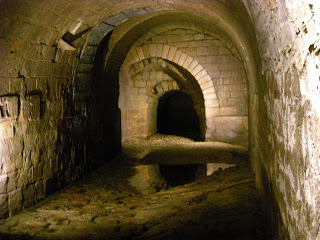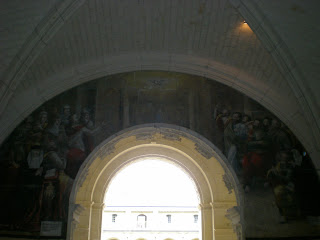Here's the castle in Saumur:

While we sat in the grass by the castle (waiting until we needed to go find the bus stop) I played with the macro setting on my camera. There were daisies, and I thought my purse would make a fun background for a flowery desktop picture.

Then I got this idea-- this is probably my favorite picture that I've taken all year. Daisies in focus, and the castle in the distance.

Fast forward to Fontevraud... here's Kristen at the Abbey. The building with the strange roof is the kitchen.

There were stocks in the herb garden. (The mint was delicious!)

Here's the kitchen from another angle, along with some of France's typical castle/religious building trees. Apparently they cut off the branches to control growth. I just think they look silly. (Though in an endearing sort of way!)

Here's a view of the subterranean tunnels. [Tip: the only successful way to take a picture in a low light setting like this, unless you have a tripod, is to use the night setting and the self timer: just find something that you can set the camera on, and let it take the picture without you touching it.]

A lot of the abbesses looked remarkably similar...

This is the image I see in my head when I think of a monastery or a convent:

One of the more important features of the abbey is its set of frescos. Here's the Last Supper/washing of the feet (and note the very modern nun).

Here's the garden of Gethsemane and Judas' betrayal:

This is the scourging, but it's very difficult to see thanks to the window...

The Crucifixion is the central piece in the room.

The removal of Jesus' body from the cross is likewise cast into shadow from the window.

Here's Jesus' burial.

Here's the Resurrection:

And the Acension cracked me up, since usually you get to see a little more of Jesus in His glory... although his feet are quite nice.

Perfect for today: here's the Pentecost.

And this one depicts the Assumption of Mary.

The church in the complex is enormous, but very little of its original splendor (frescos, stained glass, carvings and statues) remains. There are, however, four rather important tombs. The one on the bottom right in this photo is a rather important one: King Richard the Lionheart, king of Anjou (the region of France of which Angers is the capital) and England. He's the King Richard from the Robin Hood stories.

Here's the outside of the church:

And that, enormous and impressive, is the Abbaye de Fontevraud! (Ah-bay-ee deuh Fohn-tuh-vroh, by the way!)


1 comment:
What an interesting place! Might Fontevraud be an instance of paleo-feminism? It is surely a source of those lurid scandals of monastic life that became best-sellers in certain circles a few hundred years ago.
Which got me thinking: Less than 100 years ago, most colleges were single-sex institutions of higher learning and intellectual purpose. These days, they feature coed dormitories. Is that "progress" an advancement of their ultimate mission?
Which of course brings to mind Santayana's maxim about history.
Post a Comment